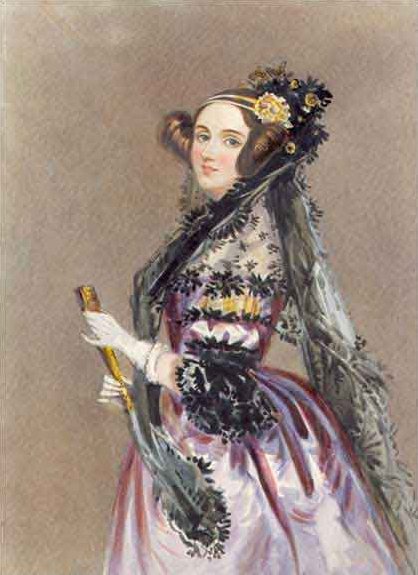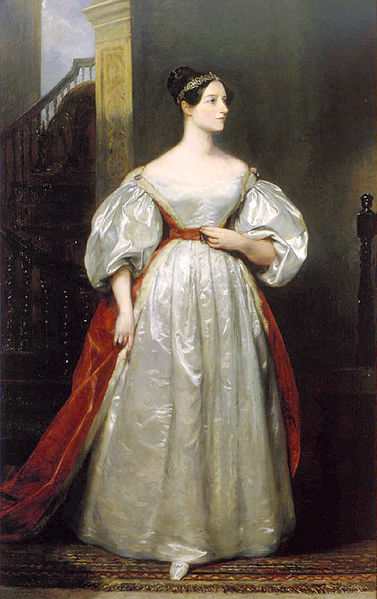<Back to Index>
- Mathematician Augusta Ada King, Countess of Lovelace, 1815
- Poet Nikolay Alexeyevich Nekrasov, 1821
- Founder of the Palestine Liberation Front Muhammad Zaydan (Abū Abbās), 1948
PAGE SPONSOR


Augusta Ada King, Countess of Lovelace (10 December 1815 – 27 November 1852), born Augusta Ada Byron, was an English writer chiefly known for her work on Charles Babbage's early mechanical general purpose computer, the analytical engine. Her notes on the engine include what is recognised as the first algorithm intended to be processed by a machine; as such she is regarded as the world's first computer programmer.
She was the only legitimate child of the poet Lord Byron (with Anne Isabella Milbanke), but had no relationship with her father, who died when she was nine. As a young adult she took an interest in mathematics, and in particular Babbage's work on the analytical engine. Between 1842 and 1843 she translated an article by Italian mathematician Luigi Menabrea on the engine, which she supplemented with a set of notes of her own. These notes contain what is considered the first computer program — that is, an algorithm encoded for processing by a machine. Though Babbage's engine was never built, Lovelace's notes are important in the early history of computers. She also foresaw the capability of computers to go beyond mere calculating or number crunching while others, including Babbage himself, focused only on these capabilities.
Ada
Augusta
Byron, born on 10 December 1815, was the only child of the poet
George Gordon, 6th Lord Byron, and his wife, Anne Isabella "Annabella"
Milbanke, Baroness Wentworth. Byron,
and
many of those who knew Byron, expected that the baby would be "the
glorious boy", and there was some disappointment at the contrary news. She was named after Byron's
half-sister, Augusta Leigh,
and was called "Ada" by Byron himself.
On 16 January 1816, Annabella, at Byron's behest, left for her parents'
home at Kirkby Mallory taking
one month old Lovelace with her. Although
English law gave fathers full custody of their children in cases of
separation, Byron made no attempt to claim his parental rights. On 21 April, Byron signed the
Deed of Separation, although very reluctantly, and left England for
good a few days later. Byron
did not have a relationship with his daughter and he died in 1824 when
she was nine; her mother was the only significant parental figure in
her life. Her
mother, Annabella, became Baroness Wentworth in her own right in 1856,
being then the sole remaining representative of the Wentworth
Viscounts. Lovelace was often ill, dating from her early childhood. At
the age of eight she experienced headaches that obscured her vision. In June 1829, she was paralysed
after a bout of the measles.
She
was subjected to continuous bed rest for nearly a year, which may
have extended her period of disability. By 1831 she was able to walk
with crutches.
Throughout
her illnesses, Lovelace continued her education. Her
mother's obsession with rooting out any of the insanity of which she
accused Lord Byron was one of the reasons that Lovelace was taught mathematics from an early age. Lovelace
was privately schooled in mathematics and science by William Frend, William King and Mary Somerville. One of her later tutors was the
noted mathematician and logician Augustus De
Morgan. From 1832, when she was seventeen, her remarkable
mathematical abilities began to emerge, and
her interest in mathematics dominated her life even after her marriage.
In a letter to Lovelace's mother, De Morgan suggested that Lovelace's
skill in mathematics could lead her to become "an original mathematical
investigator, perhaps of first-rate eminence". Lovelace
never met her younger half-sister, Allegra Byron,
daughter of Lord Byron and Claire Clairmont,
who died in 1822 at the age of five. She did, however, have some
contact with Elizabeth
Medora Leigh,
the daughter of Byron's half-sister Augusta Leigh. Augusta Leigh
purposely avoided Lovelace as much as possible when she was introduced
at Court.
Lovelace knew Mary Somerville,
noted
researcher and scientific author of the 19th century, who
introduced her to Charles Babbage on 5 June 1833. Other acquaintances
were Sir David
Brewster, Charles
Wheatstone, Charles Dickens and Michael Faraday.
By
1834, Lovelace was a regular at Court and started attending various
events. She danced often and was able to charm many people and was
described by most people as being dainty. However, John Hobhouse,
Lord
Byron's friend, was the exception and he described her as "a
large, coarse skinned young woman but with something of my friend's
features, particularly the mouth". This
description
followed their meeting on 24 February 1834 in which
Lovelace made it clear to Hobhouse that she did not like him, probably
due to the influence of her mother, which led her to dislike all of her
father's friends. This first impression was not to last, and they later
became friends. On 8 July
1835 she married William King,
8th Baron King, later 1st Earl of
Lovelace in
1838. Her full title for most of her married life was "The Right
Honourable the Countess of Lovelace". Their residence was a large
estate at Ockham Park, in Ockham, Surrey,
along with another estate and a home in London. They had three children; Byron born 12 May 1836, Anne
Isabella (called Annabella, later Lady Anne Blunt)
born 22 September 1837 and Ralph Gordon born
2 July 1839. Immediately after the birth of Annabella, Lovelace
experienced "a tedious and suffering illness, which took months to
cure". In 1841,
Lovelace and Medora Leigh (daughter
of Lord Byron's half-sister Augusta Leigh) were told by Lovelace's
mother that Byron, her father, was also Medora's father. On 27 February 1841, Lovelace
wrote to her mother: "I am not in the least astonished.
In fact you merely confirm what I have for years and years felt scarcely a doubt
about, but should have considered it most improper in me to hint to you
that I in any way suspected". Lovelace
did not blame the incestuous relationship on Byron, but instead blamed
Augusta Leigh: "I fear she is more inherently wicked than he ever was". This
did not prevent Lovelace's mother from attempting to destroy her
daughter's image of her father, but instead drove her to attack Byron's
image with greater intensity. Ada
Lovelace met and corresponded with Charles Babbage on many occasions,
including socially and in relation to Babbage's Difference
Engine and Analytical
Engine.
Babbage was impressed by Lovelace's intellect and writing skills. He
called her "The Enchantress of Numbers". In 1843 he wrote of her: possible
its multitudinous Charlatans — every thing During a
nine month period in 1842 – 43, Lovelace translated Italian
mathematician Luigi Menabrea's
memoir on Babbage's newest proposed machine, the Analytical Engine.
With the article, she appended a set of notes. The notes are longer than the
memoir itself and include (Section G), in complete detail, a method for
calculating a sequence of Bernoulli
numbers with
the Engine, which would have run correctly had the Analytical Engine
ever been built. Based on this work, Lovelace is now widely credited
with being the first computer
programmer and her
method is recognised as the world's first computer program.
However, some biographers debate the extent of her original
contributions. Dorothy Stein, author of Ada: A Life and a Legacy,
contends that the programs were mostly written by Babbage himself. Babbage wrote the following on
the subject, in his Passages from the Life
of a Philosopher (1846): The
level of impact of Lovelace on Babbage's engines is difficult to
resolve due to Babbage's tendency not to acknowledge (either orally or
in writing) the influence of other people in his work. However,
Lovelace was certainly one of the few people who fully understood
Babbage's ideas and created a complex program for the Analytical
Engine; indeed there are numerous clues that she might also have
suggested the usage of punched cards for Babbage's second machine since
her notes in Menabrea's memoir suggest she deeply understood the Jacquard loom as
well as the Analytical Engine. Her prose also acknowledged some
possibilities of the machine that Babbage never published, such as
speculation that "the engine might compose elaborate and scientific
pieces of music of any degree of complexity or extent". Lovelace
died at the age of thirty-six, on 27 November 1852, from uterine cancer and bloodletting by her physicians. She was buried, at her request,
next to her father at the Church of St.
Mary Magdalene in Hucknall, Nottingham. In 1842
Charles Babbage was invited to give a seminar at the University of
Turin about his
analytical engine. Luigi Menabrea,
a young Italian engineer,
and future prime minister
of Italy, wrote up Babbage's lecture in French,
and this transcript was subsequently published in the Bibliothèque
Universelle de Genève in
October 1842. Babbage asked the Countess of Lovelace to translate
Menabrea's paper into English,
subsequently requesting that she augment the notes she had added to the
translation. Lady Lovelace spent most of a year doing this. These
notes, which are more extensive than Menabrea's paper, were then
published in The Ladies'
Diary and Taylor's Scientific
Memoirs under
the initialism "A.A.L.". In
1953, over one hundred years after her death, Lady Lovelace's notes on
Babbage's Analytical Engine were republished. The engine has now been
recognised as an early model for a computer and Lady Lovelace's notes
as a description of a computer and software.
Her notes were labelled alphabetically from A to G. In note G, the
Countess describes an algorithm for the analytical engine
to compute
Bernoulli numbers.
It is generally considered the first algorithm ever specifically
tailored for implementation on a computer, and for this reason she is
considered by many to be the first computer
programmer. The
computer language Ada,
created on behalf of the United States
Department of Defense, was named after Lovelace. The reference
manual for the language was approved on 10 December 1980, and the Department of
Defense Military Standard for
the language, "MIL-STD-1815", was given the number of the year of her
birth. Since 1998, the British
Computer Society has
awarded a medal in her name and
in 2008 initiated an annual competition for women students of computer
science. In
popular media, Lady Lovelace has been portrayed in the film Conceiving Ada and the book The Difference
Engine by William Gibson
and Bruce Sterling. 24
March has been commemorated by some as Ada Lovelace Day, a
day to celebrate the achievements of women in technology and science.
in short but the Enchantress of Numbers.